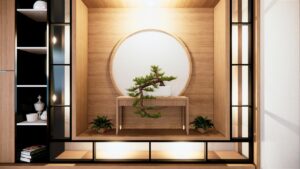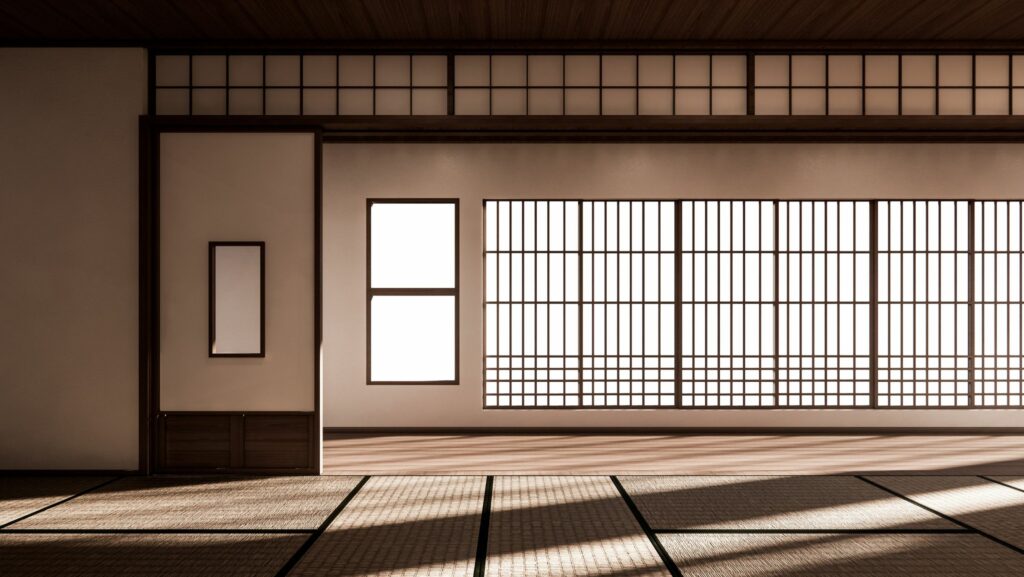Immerse yourself in the serene world of Japanese home design. A style marked by simplicity, functionality, and a deep connection with nature, it’s a design philosophy that’s been captivating homeowners and designers worldwide.
In the heart of Japanese design lies the concept of ‘Ma’, which celebrates the beauty of empty space. This, coupled with the use of natural materials, creates a harmonious environment that’s both calming and visually appealing.
So, if you’re looking to transform your living space into a tranquil haven, or simply curious about the principles behind this intriguing design style, you’re in the right place. Let’s embark on a journey to explore the elegance and minimalism of Japanese home design.
Japanese Home Design
 Gaining inspiration from the culture’s aesthetics and principles, the Japanese home design embodies a blend of simplicity, tranquility, and functionality.
Gaining inspiration from the culture’s aesthetics and principles, the Japanese home design embodies a blend of simplicity, tranquility, and functionality.
Central to Japanese home design, it’s the minimalist approach, a shift toward prioritizing functionality over excess. Straight lines and natural materials reign supreme, culminating to create open, breathable spaces that resonate with serenity. Traditional Japanese homes often incorporate Tatami mats, made from woven straw and used as flooring in varying proportions, to set the ambiance. Sliding doors, or Fusuma, made from wood and translucent paper, demarcate rooms, their strategic use enabling space manipulation.
Additionally, Japanese home decoration doesn’t just rely on furniture. Bonsai trees, for example, serve as natural artwork, and spotlights strategically illuminate corners, creating striking interplays of light and shadow. In essence, the designs harmonize man-made elements with nature, promoting balance and tranquility.
Influence of Cultural Values
Japanese home design doesn’t operate in isolation; it’s steeped in, and borrows heavily from, cultural values. Underpinning its philosophy, it’s the concept of ‘Ma’. This concept interprets space as more than mere absence but as an entity with its own energy.
Another cultural value manifesting in Japanese home design is ‘Miyabi’. It refers to the ideal state of elegance and refinement, which finds expression in subtle hints of sophistication rather than overt luxury.
Architectural Elements of Japanese Homes
 Japanese home design is unique, offering an experience of tranquility, functionality, and most importantly, a seamless blend with nature. However, these design elements do not make their significance on their own. Two unifying elements tie these features together: the role of natural materials and the importance of natural light.
Japanese home design is unique, offering an experience of tranquility, functionality, and most importantly, a seamless blend with nature. However, these design elements do not make their significance on their own. Two unifying elements tie these features together: the role of natural materials and the importance of natural light.
Understanding Japanese home design necessitates recognition of the immense value placed on natural materials. The Japanese hold a belief that dwellings are transient, which strongly influences their architectural choices. Natural materials, known to decay over time, illustrate this transient nature and subtly hint at the impermanence of life.
Traditional Japanese homes extensively utilize wood, bamboo, rice straw, and paper in their construction. For example, Tatami mats, a staple in Japanese homes, are made of woven straw, making them flexible and perfect for multi-purpose living spaces. Fusuma sliding doors incorporate both paper and wood to facilitate privacy while maintaining natural flow. The use of natural materials not only boosts the tranquility of the spaces but also satisfies the functional needs of the dwellers.
Interior Design Principles in Japanese Home Design
 Diving deeper into Japanese home design unravels the intriguing principles that govern aesthetics and structure. We’ll take a closer look at a couple key aspects: minimalism and functionality along with the use of neutral colors.
Diving deeper into Japanese home design unravels the intriguing principles that govern aesthetics and structure. We’ll take a closer look at a couple key aspects: minimalism and functionality along with the use of neutral colors.
In Japanese home design, it’s not uncommon to find an affinity for minimalist decoration and understandably so. Minimalist aesthetics, pivoting on simplicity and restraint, are central to the composition of living spaces. Spaces are purged of extraneous objects, conserving only elements that serve a purpose or have symbolic significance, such as carefully chosen furniture or artistic pieces. It’s an interior theme enriched with functionality. For instance, multi-functional furniture, capable of transforming into different configurations, comprises a core element in optimizing space productivity.
This philosophy represents simplicity in Japanese culture, resonating with the theme of ‘Less is More’, and it’s remarkably appealing. For example, built-in storage systems are characteristically tucked away within clean lines of wardrobes and beneath raised Tatami floors.

